 Food map: Eat your way around Korea
Food map: Eat your way around Korea
Follow this foodie's guide to find the best regional cuisine
Think of it as a delicious treasure map. They say it takes a village to raise a child.
But in Korea it takes the legacies of a region to create a legendary dish.
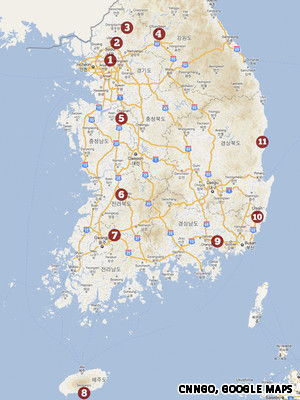
Ancient royal lunches, former fertilizers, dishes that look too pretty (or too hideous) to eat -- these regional South Korean delicacies have been local favorites for years.
Now, they offer the savvy traveler an alternative to mediocre franchise fare.
1. Seolleongtang (설렁탕), Seoul
Seoul has been incorporating regional dishes into its local menu for as long as it's been a center of culture and commerce in Korea.
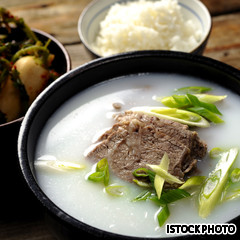
Case in point: Seoul may not have invented bibimbap, but it's crawling with bibimbap restaurants.
One undeniably local food is seolleongtang, a murky, off-white ox-bone soup that's hearty and filling for all of its thin, almost-watery consistency.
Seolleongtang began as part of a spring ritual in the Joseon Dynasty to honor farming. Part of the ceremony involved slaughtering a cow as a sacrifice to Dangun (founder of Korea's first kingdom) and making it into a soup.
Upon observing the ceremony, King Seongjong ordered that the cow be cooked more efficiently, in order to feed the most people with the least amount of food.
It's a damn good broth that can sell this well with such an unassuming appearance. Thus was Seolleongtang created to yield maximum flavor with the minimum of meat.
This satisfying soup might explain how Koreans have put up with Seoul's punishing winters in recent years -- when eaten with rice, the lack of actual meat in the soup isn't a problem.
With seolleongtang, it's all about the broth.
The deep, full flavor comes from the ox bone, which is cooked in the soup for ten-odd hours. The pale, white'ish color comes from the ox-bone marrow.
Try it at: Sinsun Seolnongtang (신선설농탕), 5-38 Changcheon-dong, Seodaemun-gu, Seoul (서울특별시 서대문구 창천동 5-38); +82 2 393 0040; www.kood.co.kr
2. Uijeongbu Budaejjigae (의정부 부대찌개), Gyeonggi Province
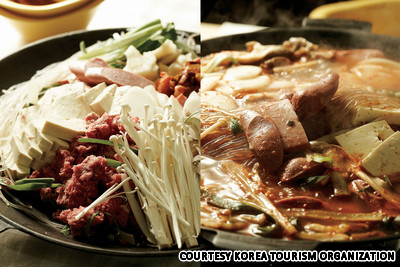
These days buddaejjigae is less about making the most out of leftovers, more about excess -- delicious excess.
Buddaejjigae, literally "Army Base stew," dates to the Korean War, when hungry chefs had to be creative with their limited resources.
They'd cook stews from U.S. Army-base leftovers like hot dog sausages, Spam and American cheese, adding Korean ingredients such as dropwort, ddeok, ramyeon noodles, kimchi and condiments like gochujang to create a spicy fusion sensation.
Buddaejjigae is sometimes referred to as "Johnson tang," tang being the Korean word for stew.
According to "About Korea's Representative Foods" (대한민국 대표 음식이야기), it's named for U.S. president Lyndon B. Johnson, who is said to have raved about the taste during a visit to Korea.
We don't blame him. It's hard to make Spam palatable, much less desirable.
Buddaejjigade spread especially rapidly in Uijeongbu, which had a high concentration of U.S. Army bases.
Today there's a "buddaejjigae" street (Gyeonggi-do Uijeongbu-si Uijeongbu1-dong) in Uijeongbu with a high concentration of buddaejjigae restaurants.
Try it at: Boyeong Restaurant (보영식당), 214-127 Uijeongbu 1-dong, Uijeongbu-si, Gyeonggi-do (경기도 의정부시 의정부1동 214-127); +82 31 845 0579
3. Pocheon Makgeolli (포천 막걸리), Gyeonggi Province
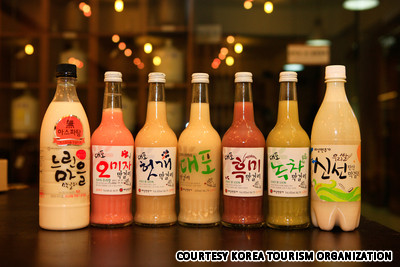
Breakfast, lunch and dinner. Or, what the hell, just breakfast.
Pocheon's claim to fame is makgeolli, a Korean rice wine, slightly sour, mostly sweet and easily identified by its creamy, off-white color.
Good makgeolli can be found around the country. Every region has its own fermenting process.
Pocheon's makgeolli has Pocheon's equally famous mineral-rich water, which is what gives the makgeolli its characteristic flavor. According to "Makgeolli Tour," by Jeong Eun-suk, Pocheon's water is said to have affected the taste of kimchi in the villages.
Try it at: Idong Makgeolli (이동막걸리); 120-8 Dopyeong-ri, Idong-myeon, Pocheon-si, Gyeonggi-do (경기도 포천시 이동면 도평리 120-8), +82 31 535 7150; www.이동막걸리.com; You can sample the makgeolli here, but for a relaxed drinking session, try take-out or pop into a nearby bar
4. Chuncheon Dakgalbi and Makguksu (춘천 닭갈비와 막국수), Gangwon Province
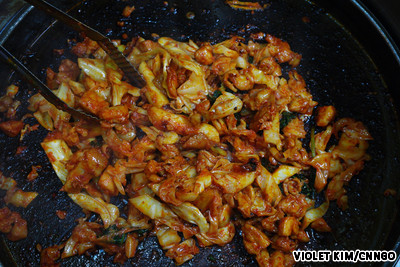
Which gochujang-covered chunk is chicken? And which is cabbage? Doesn't matter, it's all dakgalbi now.
Chuncheon, Gangwon-do is known for two things: dakgalbi and makguksu.
Dakgalbi started out as a dish of grilled chicken bits in an area where chicken was cheap.
Today, dakgalbi is seasoned and deboned chicken stir-fried with sliced tteok, sweet potato, perilla leaves and cabbage.
Makguksu is buckwheat noodles in a chilled kimchi stock, often with additional flavors in the form of sugar, mustard, sesame oil or vinegar. The noodles are topped with whatever vegetables strike the chef's fancy.
These perfectly matched dishes form the yin and yang of a frugal and filling meal.
We say frugal because noodles were traditionally the sustenance of the poor, and because dakgalbi was historically the favorite of the poor -- at a mere ₩100 per serving in the 1970s, it was popular with soldiers and students, thus gaining the nickname "commoner's galbi" or "university student's galbi."
Dakgalbi is a recent invention, created in the 1960s. It's spicy, sweet and meaty, served hot on the same table it's cooked on.
Makguksu, on the other hand, has been around since the Koryeo Dynasty. It's spicy, savory and wheaty, served chilled.
The harmonious taste of these two dishes together is for the diner to decide, but meanwhile, the twenty-odd dakgalbi restaurants in Chuncheon's "Dakgalbi Alley" will continue to serve them together.
Try it at: Youmi Dakgalbi (유미닭갈비); 51-9 Joyang-dong, Chuncheon-si, Gangwon-do (강원도 춘천시 조양동 51-9), +82 33 244 4455; www.youmi.kr
5. Byeongcheon Sundae (병천순대), South Chungcheong Province
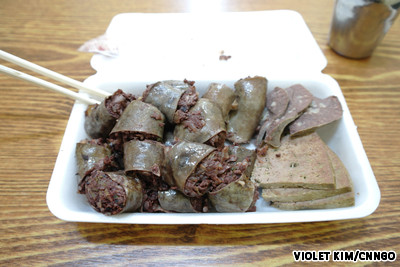
Unlike generic street sundae, casing is real intestine, not fake translucent stuff.
Sundae, at its most basic, is a type of blood pudding: pig or cow intestines stuffed with glass noodles, ground meat and vegetables. And congealed blood. All steamed into coils of unassuming but tasty meaty goodness, ready to be sliced and served -- usually with other pork parts, like lung and heart, on the side.
Sundae has been around since at least the sixth century; China's oldest cookbook from the time has an account of a mutton sundae, according to best-selling restaurant guide "Baeknyeonmyeongga" (백년명가).
Supposedly, Ghengis Khan's army embraced sundae as a portable and nutritious meal on the go.
In Korea, the dish has spawned regional variations -- sundae stuffed into squid, sundae made exclusively with large intestine, sundae made with small intestine, sundae of multiple shades of cooked pork blood and finally Byeongcheon sundae, notable for its "especially black color," finely ground meat and soft, juicy consistency.
Try it at: Piggy's Sundae (돼지네 순대); 166-16 Byeongcheon-ri, Byeongcheon-myeon, Dongnam-gu, Cheongan-si, Cheongcheongnam-do (충청남도 천안시 동남구 병천면 병천리 166-16), +82 41 564 1077
6. Jeonju Bibimbap (전주 비빔밥), North Jeolla Province

Don't be fooled. Bibimbap only looks pretty when it's being served. The first thrust of the spoon and it's a mess. A delicious mess.
As one of Korea's most well-known foods, this lunchtime favorite has modern fusion and interregional reincarnations.
You you can get as flashy as you want -- go vegetarian, add seafood -- with all these takes, but Jeonju bibimbap is by far the most famous, and its popularity endures.
Perhaps it has something to do with Jeonju's widely acknowledged reputation as both a neighborhood of nobles (yangban) and a leader of taste.
To the Korean noblemen, who were all about ceremony, bibimbap had to have looked pretty damn good on the table, its multi-colored ingredients packed neatly in a bowl.
The irony, of course, is that bibimbap tastes good only after the carefully arranged ingredients are mashed unceremoniously together.
Try it at: Jongno Hall (종로회관), 60-1 Jeon-dong, Wansan-gu, Jeonju-si (전주시 완산구 전동 60-1); +82 63 288 4578; jongrofood.jjf.co.kr
7. Damyang Daetongbap and Tteokgalbi (담양 대통밥과 떡갈비), South Jeolla Province

Daetongbap. Fragrant and healthy. And no one has to do the dishes.
Damyang is famous for its bamboo. It has a Bamboo Theme Park, Bamboo Festival, a large bamboo garden and bamboo museum.
But for the wandering gourmand, Damyang's best bamboo innovation may be its bamboo rice, or daetongbap.
Damyang daetongbap is rice cooked into the fragrant segment of a bamboo stalk. It's often cooked with chestnuts, jujubes, pine nuts or other nuts, grains and berries.
While this is an agreeable mixture, a bamboo stalk, to some, might sound too slim to be capable of containing a full meal. But the hungry need not fear. The bamboo segment comes from thick, fully formed bamboo more than three years old.
Because much of the fragrance of the daetongbap comes from the natural bamboo oils of the bowl, the bamboo is only used once. Good thing Damyang has plenty of it.

"Why don't we take this perfectly fine galbi, grind it up and put it back together?" Sounds like a dumb idea, till you try it. Damyang's specialties don't end with scented rice. Damyang also has tteokgalbi, ground galbi seasoned and shaped into a patty.
As futile as this action may seem (grinding, only to put back together), tteokgalbi has several advantages over galbi: it's much softer, while retaining enough chewiness to feel like meat.
Eating it is less of a hassle. No gnawing on galbi bones.
Try it at: Deokinkwan (덕인관), 408-5 Baekdong-ri, Damyang-eup, Damyang-gun, Jeollanam-do (전라남도 담양군 담양읍 백동리 408-5); +82 61 381 7881; www.deokinkwan.com
8. Jeonbokjuk (전복죽), Jeju Island

The gateway spoonful. Get past the hue and the goo and you just might discover your new favorite porridge. Jeonbokjuk is a rice-based porridge made with chewy abalone and sesame oil, and one of the tributes that Jeju Island residents historically presented to the king.
And no wonder. Besides the savory taste and comforting texture jeonbokjuk also has merit as a health food.
It's said to be especially beneficial to the pregnant, the old and the sickly -- basically anyone eligible to take your seat in the subway.
Properly made, Jeju Island jeonbokjuk uses the innards, as well as the chewy yellow outer meat of the abalone, and is thus a tell-tale shade of pale, almost unappetizing green.
But one spoonful and positive associations take over.
Try it at: Ojo Haenyeoui jip (오조 해녀의 집), 3 Ojo-ri, Seungsan-eup, Seogwipo-si, Jeju-do (제주특별자치도 서귀포시 성산읍 오조리 3); +82 64 784 0893
9. Masan Agujjim (마산 아구찜), South Gyeongsang Province

Agujjim looks like salad from hell. Before the blackmouth angler, or the agu's, meteoric rise to main-dish status at meals as the "meat of the sea," it was considered ugly and unfit to eat.
Instead, it was used as fertilizer.
Now, agu is the main ingredient in agujjim, a dish of braised blackmouth angler on a bed of bean sprouts and minari (dropwort), saturated in a marinade of chilli pepper powder (gochugaru), soy sauce and garlic.
This glorious, fiery (in color and taste) seafood favorite is eaten all over Korea.
According to "About Korea's Representative Foods" (대한민국 대표 음식 이야기), agujjim was born in in the 1950s in Masan, Gyeongsangnam-do, in a bar in Odong-dong, Masan, when a poor fisherman brought this lowly fish to the cook who ran the bar and asked her to cook it.
Initially, the cook rejected the fish for its extremely ugly appearance and chucked it away in her kitchen. But a month later, while desperately casting around for ingredients, the cook discovered the now dried-up agu and decided to braise it.
It was an instant hit. The period of lonely dehydration that the abandoned agu had gone through in the kitchen had given the meat an incomparable chewiness.
Try it at: Granny Gugang's Agujjim (구강할매아구찜), 185 Odong-dong, Happo-gu, Masan, Changwon-si, Gyeongsangnam-do (경상남도 창원시 마산 합포구 오동동 185); +82 55 246 0492
10. Eonyang Bulgogi (언양 불고기), Ulsan

Eonyang bulgogi skips the pan and goes straight to the fire.
Ulsan, Korea's seventh-largest city, is an industrial center.
It's more Manchester than London. More Detroit than Chicago. And it's better known for its sprawling factories than its fine dining.
Yet some of the nation's best bulgogi can be found there: Eonyang bulgogi.
Bulgogi, literally "fire meat," is thinly sliced beef grilled in a distinctive marinade of sugar and soy sauce, sometimes pear juice and usually onions. It's everywhere -- from fancy franchises to pan-ready kits at local Lotte Marts.
It sounds delicious and easy to make, and it is delicious and easy to make.
But Ulsan's arguably superior Eonyang bulgogi requires more than a simple stir and fry.
Hailing from a district known for its many butcher shops, Eonyang bulgogi is not just another regional take, it's a region-specific brand.
Noted for the freshness of the meat (all meat is served within 24 hours of butchering, and comes only from cows who have calved fewer than three times), Eonyang bulgogi is cooked in a specific way: with white coals, made by patting dirt over reddened coals preheated in a charcoal kiln.
The best part is that this meticulously prepared dish, somehow a product of oil-rig-ridden Ulsan rather than yang-ban-ridden Jeonju, really caught fire only after it was "discovered" in the 1960s by construction workers who were in Ulsan to build the highway.
Construction worker by day and foodie by night? Sounds just right.
Try it at: Eonyang Traditional Bulgogi (언양 전통 불고기), 167-6 Seobu-ri, Eonyang-eup, Ulju-gun, Ulsan-si (울산시 울주군 언양읍 서부리 167-6); +82 52 262 0940; www.jeontongbulgogi.com
11. Yeongduk Daegejjim (영덕 대게찜), North Gyeongsang Province

If you're a king, try not to get it on your face.
Daegae is the Korean word for "snow crab," a delectable crab with a thin shell and very long legs -- legs which apparently resembled bamboo to some our ancestors, because the "dae" in daegae means "bamboo."
Yeongdeok Daegejjim isn't so much a dish -- after all, it's simply steamed snow crab -- as a lucky biological quirk.
Due to a variety of environmental factors, Yeongdeok happens to be prime crab breeding ground, and there's not much you can do to improve the taste of steamed crab meat, tender, juicy and fluffy.
But food is food, and no less delicious because it's not slathered in a complicated sauce.
The love story between a king and his snow crab, as retold in "About Korea's Representative Foods," demonstrates the sort of dedication this irresistible meat has inspired throughout Korean history.
According to the book, there was once a king who loved his steamed crab so much that he got it all over his face in his enthusiasm. His concerned servants, thinking such behavior unseemly for a king, banned daegaejjim. But the king, haunted by the taste, commanded that it be brought forth to him again.
Today, Yeongdeok celebrates its snow crab with a festival. Highlights are exactly what might be expected from a festival celebrating delicious seafood: sampling delicious seafood.
Try it at: Any of the restaurants on Ganggu Harbor (강구항), such as Myeongga Daegae (명가 대게), 408 Ganggu-ri, Ganggu-myeon, Yeongduk-gun, Gyeongsangbuk-do (경상북도 영덕군 강구면 강구리 408번지); +82 54 734-5525
By Violet Kim 6 April, 2012
|


